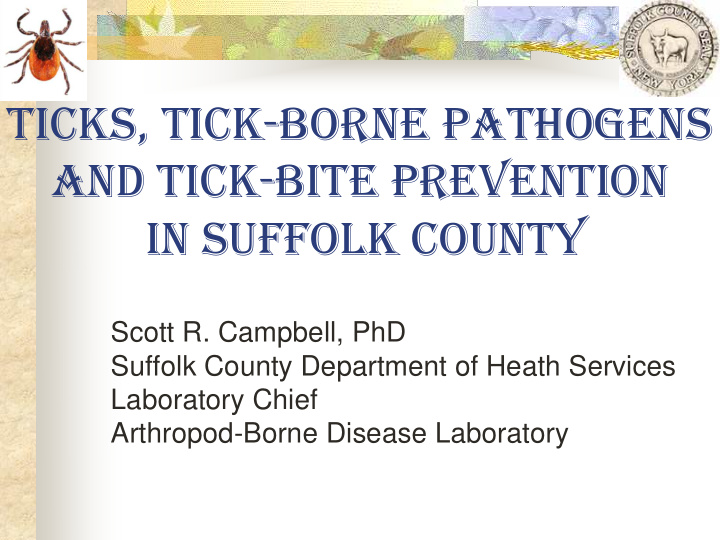



Ticks, Tick-Borne Pathogens and Tick-Bite Prevention in Suffolk County Scott R. Campbell, PhD Suffolk County Department of Heath Services Laboratory Chief Arthropod-Borne Disease Laboratory
Ticks of Medical Importance ◼ Blacklegged or Deer Tick ◼ Ixodes scapularis (Ixodes dammini) American Dog Tick ◼ ◼ Dermacentor variabilis ◼ Lone Star Tick ◼ Amblyomma americanum
Blacklegged or Deer Tick ( Ixodes scapularis )
Questing Tick
Blood Feeding
Tick Life Cycle – 2 Year
Tick-Borne Pathogens Associated with Blacklegged/Deer Ticks ◼ Lyme Disease, Lyme Borreliosis ◼ Borrelia burgdorferi ◼ Human Granulocytic Anaplasmosis (HGA) ◼ Anaplasma phagocytophilum ◼ Babesiosis ◼ Babesia microti ◼ Powassan Virus or Deer Tick Virus Canadian Medical Association Journal
Coinfection of pathogens for Lyme Disease Anaplasmosis Babesiosis may occur from one tick bite
White-Footed Mouse White-Tailed Deer Peromyscus leucopus Odocoileus virginianus
American Dog Ticks ( Dermacentor variabilis ) Male Female
Tick-Borne Pathogens Associated with American Dog Ticks ◼ Rocky Mountain Spotted Fever ◼ Rickettsia rickettsii
Meadow Vole Red Fox Microtus pennsylvanicus Vulpes vulpes www.enature.com http://www.arlington-tx.gov
Lone Star Ticks (Amblyomma americanum ) Larva Male Female Nymph
“Chiggers”
Larval Chigger vs. Larval Tick http://science.howstuffworks.com/zoology/insects-arachnids/chigger2.htm http://www.aldf.com/Lonestarposter.shtml
Chigger Feeding http://en.wikipedia.org/wiki/Trombiculidae
Tick-Borne Pathogens Associated with Lone Star Ticks ◼ Human Monocytic Ehrlichiosis (HME) ◼ Ehrlichia chaffeensis ◼ Alpha-Gal Meat Allergy
White-Tailed Deer Odocoileus virginianus
Incidence of Tick-Borne Diseases
Tick Habitat ◼ Blacklegged (Deer) Tick ◼ Woodlands ◼ American Dog Tick ◼ Fields ◼ Lone Star Tick ◼ Woodlands, Secondary Growth, Disturbed Areas
Prevention of Tick Bites ◼ Avoid tick habitats if possible Avoid sitting directly on the ground ◼ Walk in the center of footpaths ◼ ◼ Check frequently for ticks Remove ticks promptly from clothing or body ◼ ◼ Wear/tuck shirts, long pants, and socks ◼ Consider using a tick repellent ◼ Use a clothes dryer to kill ticks 10 minutes ◼ Don’t wash first ◼
Tick and Mosquito Repellents recommended by CDC ◼ Permethrin – Clothing Only ◼ DEET ◼ Picaridin ◼ Oil of lemon eucalyptus (OLE or PMD) ◼ IR3535 ◼ Follow label directions https://www.epa.gov/insect-repellents/find-repellent-right-you
Tick Mouthparts
Proper Tick Removal http://www.health.harvard.edu
Further Information ◼ SBSH Tick-Borne Disease Resource Center ◼ Medical Questions (10am-2pm), Tick Kits ◼ (631) 726-TICK (8425) ◼ Suffolk County Department of Health Services ◼ (631) 787-2200 ◼ Tick.Prevention@suffolkcountyny.gov ◼ Suffolk County Website ◼ CDC and NYSDOH Websites
www.lymenet.de
Recommend
More recommend